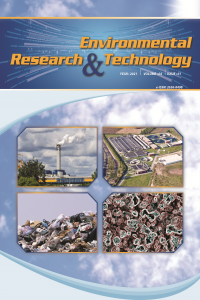Conference Paper
Year 2021,
Volume: 4 Issue: 1, 97 - 101, 31.03.2021
The "zero waste" movement has recently gained importance as an alternative to the dominant "take-use-waste" production model and as a viable approach to climate change. Zero waste is a change of perspective. It requires think again about what we traditionally regarded as garbage and instead addressing all materials as valuable resources. Zero waste takes into account the entire material management system, from extraction of natural resources to product design, production and distribution, product use and reuse, recycling, composting, energy recovery and disposal. This paper discusses a variety of zero waste strategy implementations and Turkey's Zero Waste Project.
Abstract
The amount of waste in the world continues to increase in the framework of the population, increase in purchasing power and technological developments since the past years and this increase necessitates the need for sustainable and integrated management of waste. The disposal of waste without being used in the recycling and recovery process causes serious resource losses, both materially and energy.
The "zero waste" movement has recently gained importance as an alternative to the dominant "take-use-waste" production model and as a viable approach to climate change. Zero waste is a change of perspective. It requires think again about what we traditionally regarded as garbage and instead addressing all materials as valuable resources. Zero waste takes into account the entire material management system, from extraction of natural resources to product design, production and distribution, product use and reuse, recycling, composting, energy recovery and disposal. This paper discusses a variety of zero waste strategy implementations and Turkey's Zero Waste Project.
References
- [1]. BP Statistical Review of World Energy, 68th edition, June 2019. Available: https://www.bp.com/content/dam/bp/business-sites/en/global/corporate/pdfs/energy-economics/statistical-review/bp-stats-review-2019-full-report.pdf., (accessed 15 December 2020).
- [2]. A. U. Zaman, S. Lehmann, “The zero waste index: a performance measurement tool for waste management systems in a ‘zero waste city,” Journal of Cleaner Production, Vol. 50, pp. 123-132, 2013.
- [3]. S. Giljum, C.Lutz, A. Jungnitz, M. Bruckner, F. Hinterberger, “Global dimensions of European natural resource use Results from the Global Resource Accounting Model (GRAM)” in IIOMME08 Seville – pp. 9-11, 2008.
- [4]. Deepak Gopinath Geography Vol. 105 (1), pp. 39-46, 2020.
- [5]. P. Palmer,“Getting to Zero Waste,” Sebastopol: Purple Sky Press, 2004.
- [6]. T. Curran, I.D. Williams, “A zero waste vision for industrial networks in Europe,” Journal of Hazardous Materials, , pp. 207–208, 3-7, 2012.
- [7]. Öztürk, 2017: 76-77 Available: http://zwia.org/ (accessed 15 December 2020).
- [8]. A. U. Zaman, “ Roadmap towards Zero Waste Cities, International Journal of Waste Resources,” Vol. 4 (2), 2014.
- [9]. F.F. Kavak, “Sıfır Atık Yönetimi: Marmara Üniversitesi Anadoluhisarı Kampüsü Örneği,” MSc thesis, İstanbul, 2020.
- [10]. B. Kopacek, Literature Review, “Approaches to zero waste,” Deliverable 1.1, Towards Zero Waste in Industrial Networks , Tech. Rep., Available: www.zerowin.eu. , 2010.
- [11]. Zero Waste Sonoma. Extended Producer Responsibility (EPR) or Product Stew-ardship and Take-back. Available: https://zerowastesonoma.gov/re-duce/residents/extended-producer-responsibility, (accessed 15 December 2020).
- [12]. Solid Waste Management, “Total Domestic Waste Disposed Per Capita”, available: https://data.gov.sg/dataset/solid-waste-management-total-domestic-waste-disposed-per-capita?view_id=e7298947-e719-49a4-96a5-81d6c4a64154&resource_id=21727d9f-dc4f-4992-a354-4375a3a766c4 ( accessed 15 December 2020).
- [13]. Singapore Zero Waste Plan, “Singapore‟s zero-waste plan aims to raise domestic recycling rate from 22 to 30 per cent by 2030”, available: https://www.ecobusiness.com/news/singapores-zero-waste-plan-aims-to-raise-domestic recyclingrate-from-22-to-30-per-cent-by-2030/, (accessed 15 December 2020).
- [14]. http://www.no-burn.org/meetourmembers-ypbb [Online]. Available: (2020).
- [15]. https://sifiratik.gov.tr/ [Online]. Available: ( 2020).
Year 2021,
Volume: 4 Issue: 1, 97 - 101, 31.03.2021
Abstract
References
- [1]. BP Statistical Review of World Energy, 68th edition, June 2019. Available: https://www.bp.com/content/dam/bp/business-sites/en/global/corporate/pdfs/energy-economics/statistical-review/bp-stats-review-2019-full-report.pdf., (accessed 15 December 2020).
- [2]. A. U. Zaman, S. Lehmann, “The zero waste index: a performance measurement tool for waste management systems in a ‘zero waste city,” Journal of Cleaner Production, Vol. 50, pp. 123-132, 2013.
- [3]. S. Giljum, C.Lutz, A. Jungnitz, M. Bruckner, F. Hinterberger, “Global dimensions of European natural resource use Results from the Global Resource Accounting Model (GRAM)” in IIOMME08 Seville – pp. 9-11, 2008.
- [4]. Deepak Gopinath Geography Vol. 105 (1), pp. 39-46, 2020.
- [5]. P. Palmer,“Getting to Zero Waste,” Sebastopol: Purple Sky Press, 2004.
- [6]. T. Curran, I.D. Williams, “A zero waste vision for industrial networks in Europe,” Journal of Hazardous Materials, , pp. 207–208, 3-7, 2012.
- [7]. Öztürk, 2017: 76-77 Available: http://zwia.org/ (accessed 15 December 2020).
- [8]. A. U. Zaman, “ Roadmap towards Zero Waste Cities, International Journal of Waste Resources,” Vol. 4 (2), 2014.
- [9]. F.F. Kavak, “Sıfır Atık Yönetimi: Marmara Üniversitesi Anadoluhisarı Kampüsü Örneği,” MSc thesis, İstanbul, 2020.
- [10]. B. Kopacek, Literature Review, “Approaches to zero waste,” Deliverable 1.1, Towards Zero Waste in Industrial Networks , Tech. Rep., Available: www.zerowin.eu. , 2010.
- [11]. Zero Waste Sonoma. Extended Producer Responsibility (EPR) or Product Stew-ardship and Take-back. Available: https://zerowastesonoma.gov/re-duce/residents/extended-producer-responsibility, (accessed 15 December 2020).
- [12]. Solid Waste Management, “Total Domestic Waste Disposed Per Capita”, available: https://data.gov.sg/dataset/solid-waste-management-total-domestic-waste-disposed-per-capita?view_id=e7298947-e719-49a4-96a5-81d6c4a64154&resource_id=21727d9f-dc4f-4992-a354-4375a3a766c4 ( accessed 15 December 2020).
- [13]. Singapore Zero Waste Plan, “Singapore‟s zero-waste plan aims to raise domestic recycling rate from 22 to 30 per cent by 2030”, available: https://www.ecobusiness.com/news/singapores-zero-waste-plan-aims-to-raise-domestic recyclingrate-from-22-to-30-per-cent-by-2030/, (accessed 15 December 2020).
- [14]. http://www.no-burn.org/meetourmembers-ypbb [Online]. Available: (2020).
- [15]. https://sifiratik.gov.tr/ [Online]. Available: ( 2020).
There are 15 citations in total.
Details
| Primary Language | English |
|---|---|
| Subjects | Environmental Engineering |
| Journal Section | Review |
| Authors | |
| Publication Date | March 31, 2021 |
| Submission Date | December 18, 2020 |
| Acceptance Date | February 17, 2021 |
| Published in Issue | Year 2021 Volume: 4 Issue: 1 |


